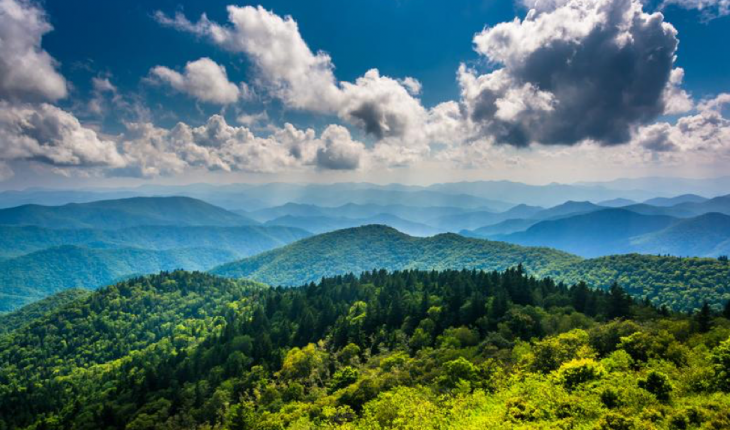The US is home to some of the most stunning landscapes in the world, some of them millions of years old. Nowhere else will you see such contrast in environments—from barren deserts and beaches to mossy swamps and lush forests. However, probably the most majestic of all are America’s mountain ranges.
Some of the oldest mountain ranges lie on the eastern coast of the US. They hold many stories and folklore of people who have lived on or near or trekked through these mountains. Dive deeper into some of these stories and interesting facts as to what role these ranges played throughout history.
Blue Ridge Mountains
Friends of the Blue Ridge Mountains talks about how over 1 billion years old, the Blue Ridge Mountains are one of the oldest, most easily reachable and most culturally intriguing ranges in the world. Their name originates from the heavily wooded areas on their peaks, which emit hydrocarbons into the air, thus creating the distinct blue color for which they are known.
In fact, much of the Eastern United States was blanketed in spruce and fir trees many thousands of years ago. As the climate became warmer, the cooler air, along with the trees, receded into the mountains where they still are today.
Both George Washington and Thomas Jefferson were enthusiasts of this awe-inspiring range, and there are countless musical homages devoted to it. The famous Blue Ridge Parkway is a 469-mile panoramic drive along the ridge, and the Appalachian Trail system is a significant recreational hot spot for hikers.
Black Hills
This small mountain range in South Dakota developed in the period between the dinosaurs’ extinction and the onset of the last ice age. It is the oldest mountain range in the United States.
Legends of America describes how it was originally called Paha Sapa – or “hills that are black” by the Lakota Native American tribe – this section of territory has been the backdrop of several battles and disagreements between white settlers and the Lakota. When President Thomas Jefferson made the Louisiana Purchase, this incorporated all of what is now South Dakota. In 1803, Meriwether Lewis and his friend, William Clark, made their famous exploration of the territory.
In 1874, despite several treaties with the Lakota by the federal government, the discovery of gold brought about thousands of miners intruding upon the territories, breaking the treaty and Federal law. This eventually triggered the final significant Indian War on the Great Plains—the Black Hills War.
Today, the Black Hills, which stretches into Wyoming, is a major tourist destination that includes the Mount Rushmore National Memorial, Black Hills National Forest and Custer State Park. The yearly motorcycle rally in Sturgis attracts more than half a million guests to the Black Hills every August.
Great Smoky Mountains
Located along the Tennessee and North Carolina state borders, the range’s moniker dates back to the time when the Cherokee inhabited the region. They named the mountains “Shaconage”, meaning “place of the blue smoke.” Sadly, the Cherokee were forcibly removed from this land in the 1830s, spurring the infamous “Trail of Tears.” Descendants of this tribe still reside there today.
Smoky Mountains By Owners explains that parts of the Smoky Mountains are over 300 million years old. The age of the mountains is calculated by the extent of weathering the rocks have experienced. You can also somewhat identify the age by the fragments identified in the soil and the trees found on the mountains.
Admission to the park is absolutely free, which is quite rare among the national parks. The Great Smoky Mountains National Park was the first park to ever be established with federal government funds.
Cumberland Mountains
320 to 200 million years ago, sedimentary rock from the Earth’s crust made its way upward, creating the Cumberland Mountains, situated in western Virginia, Kentucky and Tennessee.
The Daniel Boone National Forest is named after the famous explorer who discovered this area – otherwise known as the gateway to the western frontier. This park consists of quiet nature, landscapes, animal watching, camping, lodges and more. Multiple varieties of trees, which cannot be found elsewhere in Kentucky, are located here.
Sheltowee Trace Adventure Resort reports, frequently called “The Niagara of the South,” Cumberland Falls pours a thundering 3,600 cubic feet of water per second over the cliff. If you are lucky enough to visit the falls on a clear night under a full moon, you may experience a “moonbow,” a curvature of white light resembling a rainbow.
Still shrouded in mystery with many stories only told by its natives, these mountain ranges hold an allure quite different from anything you will experience elsewhere. You can sense the beauty, the hardships of the ancestors, and the amazing ancient geology. It is a lifetime experience no one will want to miss.
Here are some other nature and ecology based articles we think you’ll find interesting:




